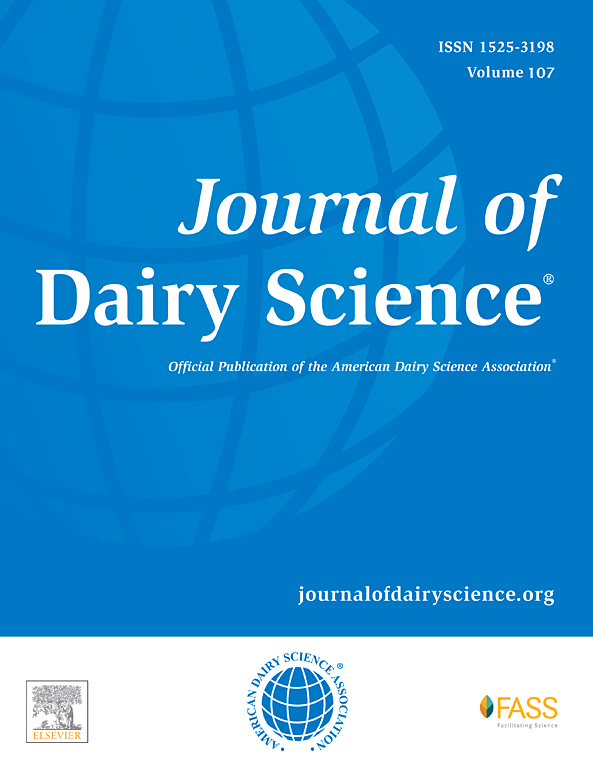荷斯坦奶牛在干乳和产犊前后的全身和乳腺炎症及乳腺发育。
IF 4.4
1区 农林科学
Q1 AGRICULTURE, DAIRY & ANIMAL SCIENCE
引用次数: 0
摘要
本研究评估了荷斯坦奶牛从泌乳后期到泌乳期(LTD, n = 6)和从泌乳期到泌乳早期(DTL, n = 7)的全身和乳腺炎症、免疫细胞数量和乳腺发育模式。所有奶牛在入组时均健康且无乳腺炎。乳腺活检、乳或乳腺分泌物和血液样本于相对于干乳的第7天、第3天、第7天和第15天以及相对于产犊的第8天、第3天、第7天和第21天采集。干燥后,LTD奶牛循环中肿瘤坏死因子(TNF)-α、接触珠蛋白和纤维蛋白原浓度升高,表明炎症水平升高。乳汁或乳腺分泌物中的蛋白质、鳞状细胞癌和固体非脂肪含量在干前期增加,但在产犊后下降。相反,乳腺分泌物中的乳糖浓度在早期干燥期降低,在产犊后升高。脱脂乳中TNF-α、白细胞介素-10和触珠蛋白的浓度在干燥后升高。在干燥后的第7天和第15天,乳腺组织中IL1B和IL10的mRNA表达均呈上升趋势。产犊后,乳腺泡细胞和总细胞的凋亡率较高。LTD奶牛乳腺组织的肺泡、间质和总细胞增殖率在干乳后第7天达到峰值,干乳后期的细胞增殖率高于泌乳早期。乳腺HGF mRNA表达在干燥后第7天和第15天升高。干后期乳腺组织IGF1、IGF2、PRLR基因表达量高于泌乳早期。干前期乳腺组织中CD20+ B淋巴细胞、CD172a+巨噬细胞和中性粒细胞的比例高于泌乳后期组织。哺乳期早期乳腺组织中CD20+ B淋巴细胞、CD3+ T淋巴细胞、CD172a+巨噬细胞的比例高于哺乳期后期组织。综上所述,奶牛在干燥期早期经历了系统性和乳腺炎症的上调,值得进一步研究以阐明其对乳腺发育的影响。我们的数据还表明,在妊娠后期和早期干燥期,乳房生长的增加是由不同的机制介导的。干枯后乳腺中免疫细胞浸润和乳腺细胞增殖同时增加,表明乳腺免疫反应与早期干枯期生长之间存在关联。本文章由计算机程序翻译,如有差异,请以英文原文为准。
Systemic and mammary inflammation and mammary gland development of Holstein dairy cows around dry-off and calving
This study evaluated systemic and mammary inflammation and the immune cell population and developmental pattern of the mammary gland in Holstein dairy cows transitioning from late lactation to the dry period (LTD, n = 6) and from the dry period to early lactation (DTL, n = 7). All cows were healthy and free of mastitis at enrollment. Mammary biopsies, milk or mammary secretions, and blood samples were collected on d −7, 3, 7, and 15 relative to dry-off and on d −8, 3, 7, and 21 relative to calving. After dry-off, LTD cows had increased circulating concentrations of tumor necrosis factor (TNF)-α, haptoglobin, and fibrinogen, suggesting upregulated inflammation. Protein, SCS, and SNF contents in milk or mammary secretions increased during the early dry period but decreased after calving. In contrast, lactose concentrations in mammary secretions decreased in the early dry period and increased following calving. Skim milk concentrations of TNF-α, IL-10, and haptoglobin increased following dry-off. Consistently, mammary tissue mRNA expression of IL1B and IL10 tended to increase on d 7 and 15 following dry-off, respectively. After calving, mammary alveolar and total cells had higher apoptosis rates. Mammary alveolar, stromal, and total cell proliferation rates peaked on d 7 after dry-off in mammary tissue collected from LTD cows and were greater in the late dry period than early lactation. Mammary mRNA expression of HGF increased on d 7 and 15 after dry-off. Mammary tissue collected in the late dry period had greater gene expression of IGF1, IGF2, PRLR than that collected in early lactation. Mammary tissues collected in the early dry period had greater percentages of CD20+ B lymphocytes, CD172a+ macrophages, and neutrophils than tissues collected during late lactation. Mammary tissues collected in early lactation had greater percentages of CD20+ B lymphocytes, CD3+ T lymphocytes, and CD172a+ macrophages than tissue collected in the late dry period. In conclusion, dairy cows experienced upregulated systemic and mammary inflammation during the early dry period, which warrants further research to elucidate its effect on mammary development. Our data also suggested that the increased mammary growth during the late gestation and early dry periods was mediated by different mechanisms. The concurrent increases in immune cell infiltration and mammary cell proliferation in the mammary gland following dry-off suggest an association between mammary immune responses and growth during the early dry period.
求助全文
通过发布文献求助,成功后即可免费获取论文全文。
去求助
来源期刊

Journal of Dairy Science
农林科学-奶制品与动物科学
CiteScore
7.90
自引率
17.10%
发文量
784
审稿时长
4.2 months
期刊介绍:
The official journal of the American Dairy Science Association®, Journal of Dairy Science® (JDS) is the leading peer-reviewed general dairy research journal in the world. JDS readers represent education, industry, and government agencies in more than 70 countries with interests in biochemistry, breeding, economics, engineering, environment, food science, genetics, microbiology, nutrition, pathology, physiology, processing, public health, quality assurance, and sanitation.
 求助内容:
求助内容: 应助结果提醒方式:
应助结果提醒方式:


